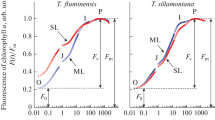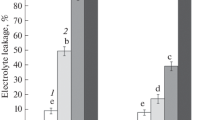Abstract.
The fluidity of chloroplast thylakoid membranes of frost-tolerant and frost-sensitive needles of␣three- to four-year-old Scots pine (Pinus sylvestris L.) trees, of liposomes produced from the lipids of the thylakoids of these needles, and of liposomes containing varying amounts of light-harvesting complex (LHC) II protein was investigated by means of electron paramagnetic resonance (EPR) measurements using spin-labelled fatty acids as probes. Broadening of the EPR-resonance signals of 16-doxyl stearic acid in chloroplast membranes of frost-sensitive needles and changes in the amplitudes of the peaks were observed upon a decrease in temperature from +30 °C to −10 °C, indicating a drastic loss in rotational mobility. The lipid molecules of the thylakoid membranes of frost-tolerant needles exhibited greater mobility. Moderate frost resistance could be induced in Scots pine needles by short-day treatment (Vogg et al., 1997, Planta, this issue), and growth of the trees under short-day illumination (9 h) resulted in a higher mobility of the chloroplast membrane lipids than did growth under long-day conditions (16 h). The EPR spectrum of thylakoids from frost-tolerant needles at −10 °C was typical of a spin label in highly fluid surroundings. However, an additional peak in the low-field range appeared in the subzero temperature range for the chloroplast membranes of frost-sensitive needles, which represents spin-label molecules in a motionally restricted surrounding. The EPR spectra of thylakoids and of liposomes of thylakoid lipids from frost-hardy needles were identical at +30 °C and −10 °C. The corresponding spectra from frost-sensitive plants revealed an additional peak for the thylakoids, but not for the pure liposomes. Hence, the domains with restricted mobility could be attributed to protein-lipid interactions in the membranes. Broadening of the spectrum and the appearance of an additional peak was observed with liposomes of pure distearoyl phosphatidyl glycerol modified to contain increasing amounts of LHC II. These results are discussed with respect to a loss of chlorophyll and chlorophyll-binding proteins in thylakoids of Scots pine needles under winter conditions.
Similar content being viewed by others
Author information
Authors and Affiliations
Additional information
Received: 3 March 1997 / Accepted: 16 July 1997
Rights and permissions
About this article
Cite this article
Vogg, G., Heim, R., Gotschy, B. et al. Frost hardening and photosynthetic performance of Scots pine (Pinus sylvestris L.). II. Seasonal changes in the fluidity of thylakoid membranes. Planta 204, 201–206 (1998). https://doi.org/10.1007/s004250050247
Issue Date:
DOI: https://doi.org/10.1007/s004250050247




